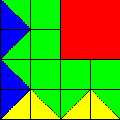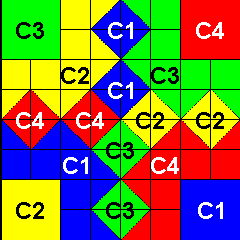





public Picture labKnit1 (Color c1, Color c2) {
Picture A1 = A(c1, c2, c1, c1, c2);
Picture A2 = A(c2,c1,c2,c2,c1);
Picture B1 = B(c1, c2, c1, c1, c2);
Picture B2 = B(c2,c1,c2,c2,c1);
return tileKnit(A1,A2,B1,B2);
}
public Picture labKnit2 (Color c1, Color c2) {
Picture A1 = A(c1,c1,c2,c2,c2);
Picture B1 = B(c2,c2,c1,c1,c1);
return tileKnit(clockwise180(B1),flipVertically(A1),B1,flipHorizontally(A1));
}
public Picture labKnit3 (Color c1, Color c2, Color c3, Color c4) {
Picture p1 = labKnit3Corner(c1,c2,c3,c4);
Picture p2 = labKnit3Corner(c2,c1,c4,c3);
return fourSame(fourPics(p1,p1,p2,p2));
}
public Picture labKnit3Corner (Color c1, Color c2, Color c3, Color c4) {
Picture A1 = A(c4,c3,c2,c2,c1);
Picture A2 = A(c4,c3,c1,c1,c2);
Picture B1 = B(c1,c2,c3,c3,c4);
Picture B2 = B(c2,c1,c3,c3,c4);
return fourPics(clockwise180(B1),flipVertically(A1),B2,flipHorizontally(A2));
}
Taking a look at the picture, we try to look for patterns. In particular, it is useful to be on the lookout for the following patterns which are available to us through our contract.
 |
 |
 |
 |
 |
 |
| patch(Color) | triangles(Color1, Color2) | fourPics(P1,P2,P3,P4) | fourSame(P) | rotations(P) | corner(P1,P2) |
Looking at the fourColors pattern, we see that we can divide it into four quarters like so:
 |
= |
|
We notice that the four quarters look like the same pattern
but the pattern is rotated clockwise 90 degrees as we go from
quadrant to quadrant in a clockwise manner.
Let's call the basic pattern (in the top right corner)
a fourColorQuadrant. We pick that pattern to be the basic pattern
so that we can use the rotations method that is given to us.
The entire fourColors pattern can now be described by the following
bit of pseudocode
pseudocode: fourColors = rotations(fourColorQuadrant)
But wait! That won't quite work because the four quarters are not exactly the same. The pattern is the same, but the colors are different. So, we can't use the rotations method which will only take one pattern and rotate it around for us. Instead, we'll have to rotate the patterns ourself. Here's our revised pseudocode
pseudocode: fourColors = fourPics(clockwise270(fourColorQuadrant(3 colors)),
fourColorQuadrant(another 3 colors),
clockwise180(fourColorQuadrant(yet another 3 colors)),
clockwise90(fourColorQuadrant(some other 3 colors)))
We have now divided the big problem fourColors into solving a smaller subproblem fourColorQuadrant. The pseudocode above tells us how to glue the subproblem solution together to form the solution to the original problem.
Now we need to figure out how to create a fourColorQuadrant. Since it's not entirely obvious, we again apply the Divide, Conquer, and Glue strategy. Taking a look at the fourColorQuadrant, we notice that we can also divide that into four quarters like so:
 |
= |
|
We see that we have a red patch in the top right quadrant and
two distinct color patterns. Let's call them pattern1
and pattern2 like so:
 pattern1 |
 pattern2 |
Take this  and rotate it 90 degrees clockwise to get and rotate it 90 degrees clockwise to get

|
fourColorQuadrant = fourPics(clockwise90(pattern1(2 colors)), redPatch,
pattern2(3 colors), pattern1(another 2 colors))Now we need to figure out how to create a pattern1. We can again divide this pattern into quadrants like so:
 |
= |
|
| Take this
|
flip it vertically | to get
|
| rotate it 270 degrees clockwise |
| Take this
|
Now we can write the following bit of pseudocode
pseudocode: pattern1 = fourPics(greenPatch, greenPatch, flipVertically(yellowGreenTriangles), yellowGreenTriangles)
We have now divided the big problem pattern1 into basic building blocks so now we can conquer this problem!
Now we need to write the actual code to create the pattern1. We should write the code so that we can generate this pattern in any two colors. To do this, let's first decide how to label our colors. Why don't we do the following:

c1 will be the color that fills the bottom triangles
c2 will be the other color which fills most of the pattern
Here's our code for the pattern1 method which will return the pattern1 Picture:
public Picture pattern1 (Color c1, Color c2) {
Picture c1c2Triangles = triangles(c1, c2); // create triangles of Colors c1 and c2
Picture c2Patch = patch(c2); // create a patch of Color c2
return fourPics(c2Patch, c2Patch, flipVertically(c1c2Triangles), c1c2Triangles);
}
Now we need to figure out how to create a pattern2. We can again divide this pattern into quadrants like so:
 |
= |
|
| Take this
|
| Take this
|
Now we can write the following bit of pseudocode
pseudocode: pattern2 = fourPics(blueGreenTriangles, greenPatch,
clockwise90(blueYellowTriangles), yellowGreenTriangles)
We have now divided the big problem pattern2 into basic building blocks so now we can conquer this problem!
Now we need to write the actual code to create the pattern2. We should write the code so that we can generate this pattern in any three colors. To do this, let's first decide how to label our colors. Why don't we do the following:

c1 will be the color that fills the triangles on the left
c2 will be the color that fills the triangles on the bottom
c3 will be the color that fills the rest of the pattern
Here's our code for the pattern2 method which will return the pattern2 Picture:
public Picture pattern2 (Color c1, Color c2, Color c3) {
Picture c1c3Triangles = triangles(c1, c3); // for top left quadrant
Picture c3Patch = patch(c3); // for top right quadrant
Picture c1c2Triangles = triangles(c1, c2); // for bottom left quadrant
Picture c2c3Triangles = triangles(c2, c3); // for bottom right quadrant
return fourPics(c1c3Triangles, c3Patch, clockwise90(c1c2Triangles), c2c3Triangles);
}
Now that we have solutions for pattern1 and
pattern2, we can write up our solution for fourColorQuadrant.
First, though, we need to decide how to label our colors.
Let's agree on the following:

c1 will be the color that fills the triangles on the left
c2 will be the color that fills the triangles on the bottom
c3 will be the color that fills the center of the pattern
c4 will be the color that fills the top right quadrant
Here's our code for fourColorQuadrant
public Picture fourColorQuadrant (Color c1, Color c2, Color c3, Color c4) {
Picture pattern1Top = pattern1(c1, c3); // for top left quadrant
Picture c4Patch = patch(c4); // for top right quadrant
Picture pattern2 = pattern2(c1, c2, c3); // for bottom left quadrant
Picture pattern1Bottom = pattern1(c2, c3); // for bottom right quadrant
return fourPics(clockwise90(pattern1Top), c4Patch,
pattern2, pattern1Bottom);
}
Now that we have a solution for fourColorQuadrant, we can write
up our solution for fourColors.
First, though, we need to label our colors. Let's do it like so:

public Picture fourColors (Color c1, Color c2, Color c3, Color c4) {
return fourPics(clockwise270(fourColorQuadrant(c4,c1,c2,c3)), // top left
fourColorQuadrant(c1,c2,c3,c4), // top right
clockwise180(fourColorQuadrant(c3,c4,c1,c2)), // bottom left
clockwise90(fourColorQuadrant(c2,c3,c4,c1))); // bottom right
}
To actually see our solutions we need to add picture choices to our applet. Add the following code to the initializePictureChoices method to see the solution to the main problem and all the subproblems that we solved.
// see the colors
addPictureChoice("fourColors", fourColors(Color.blue, Color.yellow, Color.green, Color.red));
// see the fourColorQuadrant
addPictureChoice("fourColorQuadrant", fourColorQuadrant(Color.blue, Color.yellow, Color.green, Color.red));
// see the pattern1
addPictureChoice("pattern1", pattern1(Color.yellow, Color.green));
// see the pattern2
addPictureChoice("pattern2", pattern2(Color.blue, Color.yellow, Color.green));